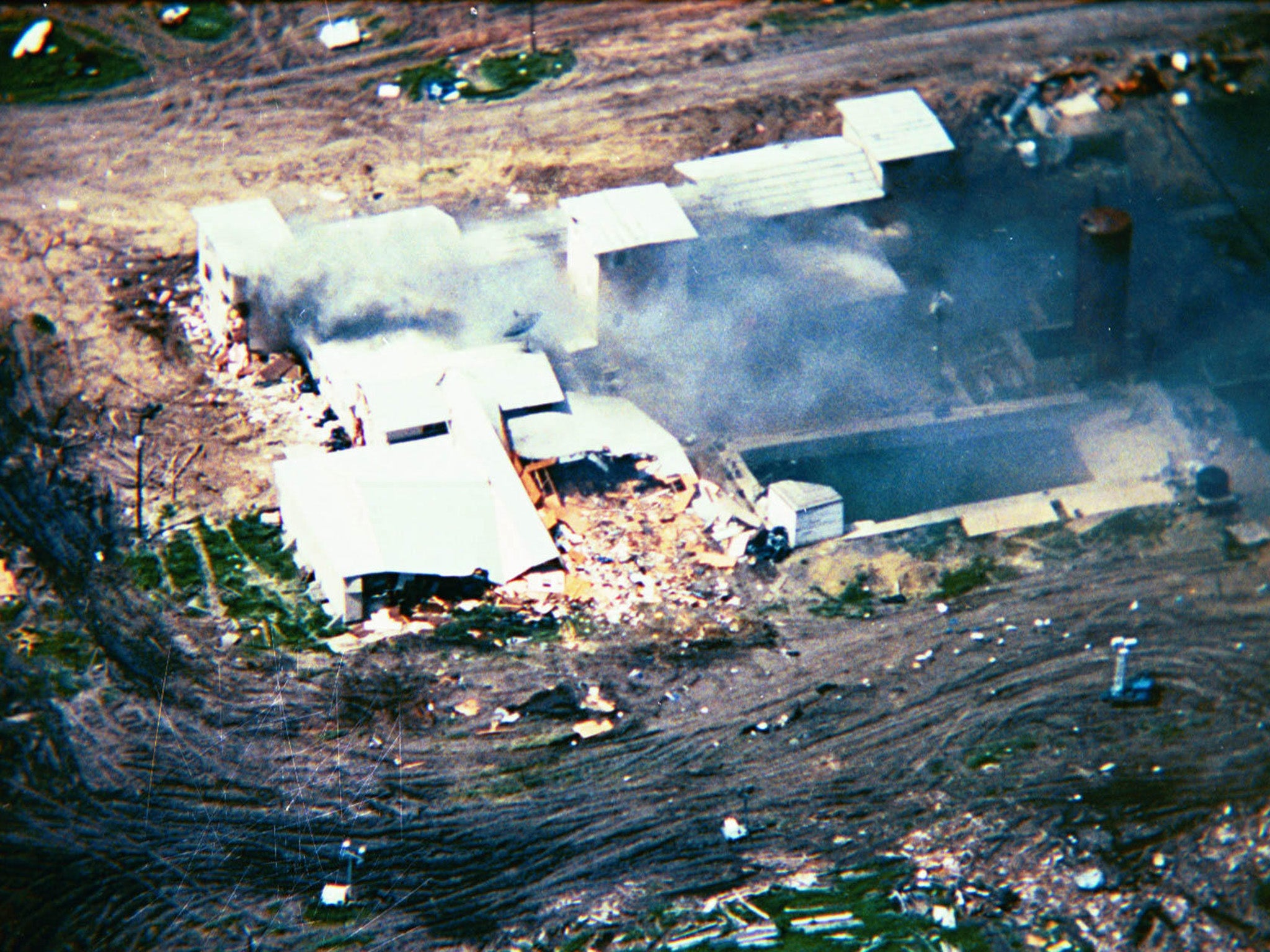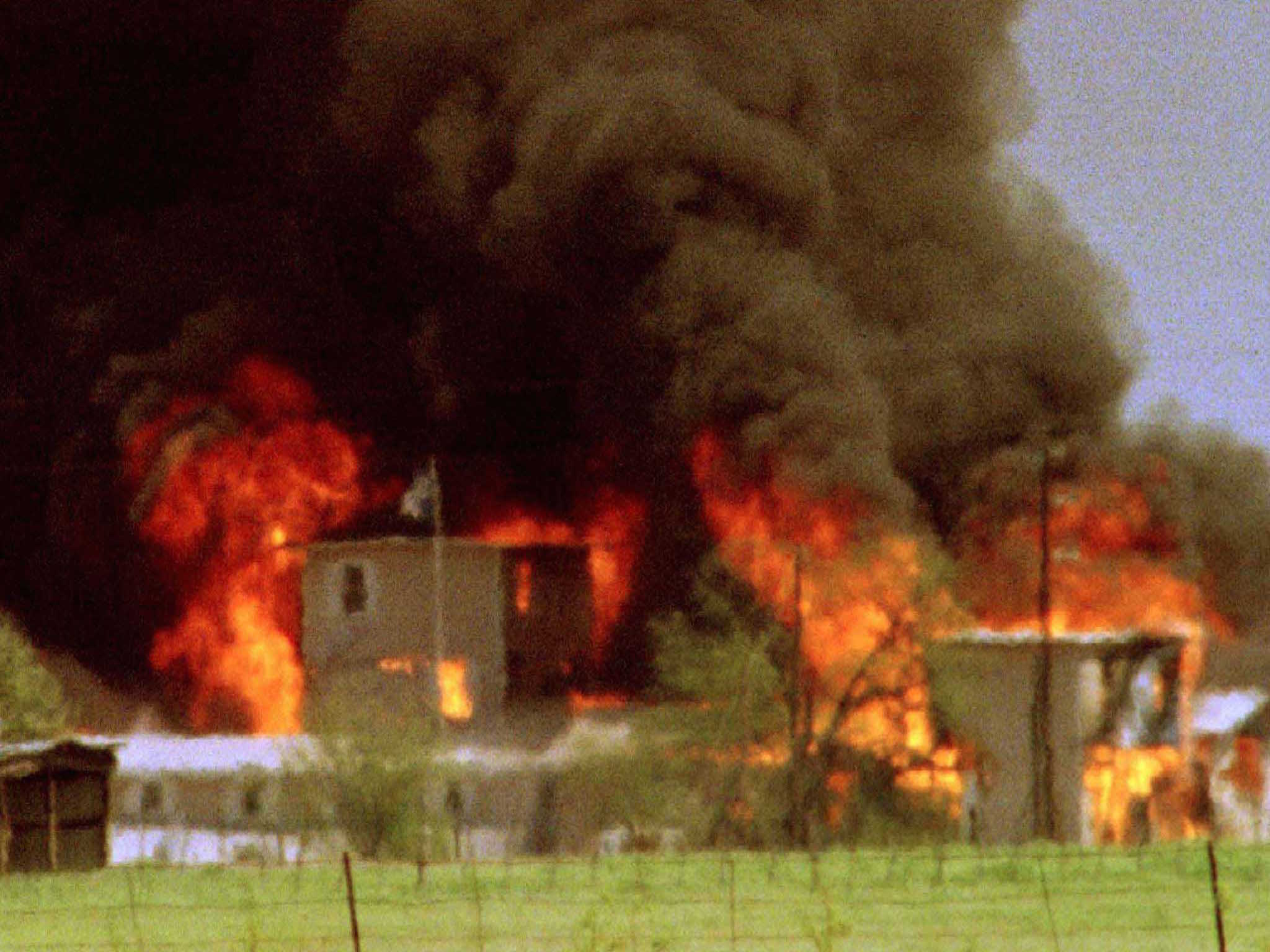Waco: How a 51-day standoff between a Christian cult and the FBI left more than 80 dead and divided America
As a Paramount TV drama may show, almost every aspect of the Waco siege that pitted sect leader David Koresh against the federal government is contested – and the controversy may have played a part in shaping today’s America

Your support helps us to tell the story
From reproductive rights to climate change to Big Tech, The Independent is on the ground when the story is developing. Whether it's investigating the financials of Elon Musk's pro-Trump PAC or producing our latest documentary, 'The A Word', which shines a light on the American women fighting for reproductive rights, we know how important it is to parse out the facts from the messaging.
At such a critical moment in US history, we need reporters on the ground. Your donation allows us to keep sending journalists to speak to both sides of the story.
The Independent is trusted by Americans across the entire political spectrum. And unlike many other quality news outlets, we choose not to lock Americans out of our reporting and analysis with paywalls. We believe quality journalism should be available to everyone, paid for by those who can afford it.
Your support makes all the difference.The siege had endured for 51 days.
For 51 days, for hour after hour, the FBI negotiators had sought agreement with a sect leader who veered between cracking jokes and threatening to start World War Three, between lucid civility and incoherent rambling about the scriptures. About the Book of Revelation in particular.
To himself and to his followers in the Branch Davidians sect, David Koresh, 33, was the almighty Lamb of God, commanding men to surrender their wives to him, fathering babies with children as young as 12, preparing them all for the imminent apocalypse.
Confronted by snipers and combat vehicles, facing an armed siege that had come to resemble the final cataclysmic battle with the government that their leader had prophesised, the Davidians refused to desert either Koresh or their squalid compound near Waco, Texas.
Instead they held children up to the windows and unfurled a sign proclaiming: “Flames Await”.
And so, wittingly or unwittingly, the Davidians foretold the denouement.
On the morning of Monday 19 April 1993, with the FBI team still seemingly divided about whether force or negotiation was the answer, the agents of law enforcement began their assault, to the accompaniment of military-grade tear gas being fired from Army-issue combat vehicles.
Only nine sect members emerged alive.
Somehow, a fire was started. Fanned by a 30mph wind, the flames destroyed the Davidians’ compound, the Biblically-named Mount Carmel Centre.
That day saw the deaths of 76 Davidians, including Koresh, 24 followers who were British citizens, and more than 20 children.
Women and children, huddling under wet blankets for protection from the blaze, were killed by falling debris. Many others were killed by smoke inhalation.
Some, though, were found shot in the head at close range. Several young children were shot and one toddler died from a stab wound to the chest.
It seemed that as the flames and federal agents approached, some Davidians followed their leader Koresh’s order to commit suicide, and took the children with them.
That, at least, is one account of the siege of Waco.
Almost every aspect of it could be, and indeed has been, challenged.
And now a new American miniseries, its first episode broadcast on Wednesday, is again stirring the embers of Waco.
If the TV drama Waco is attracting enormous attention, that’s hardly surprising.
The Waco siege was never just about a bizarre sect, a failed negotiation and a disastrous raid.
In some ways, it was a fatal collision of things that have helped make, and occasionally threaten to break, America.
Waco combined God and guns – the right to religious freedom and the right to bear arms – with the fear that federal government would remove those rights, and federal government’s fear of its more extreme citizens.
It saw a government acting partly out of fear of domestic terrorism embark on a siege that would come to support narratives later exploited by domestic terrorists.
Because in some quarters, Koresh and the Davidians were martyrised as a community of God-fearing if unconventional Christians whose freedoms should have been guaranteed by the US Constitution, but who were instead killed by an ever more controlling government.

And two years to the day after the end of the Waco siege, such views were taken to perverse extremes. On 19 April 1995 Oklahoma City bomber Timothy McVeigh claimed to be avenging the Davidians when he killed 168 people in his attack on the Alfred P Murrah Federal Building.
Small wonder, then, that from how it started to how it finished and beyond to its aftermath, everything about Waco is contested.
The Paramount Network miniseries seems to be leaning towards a view that Koresh and his followers were without violent intent, and misunderstood.
And that’s not totally implausible. The Davidians were well known locally, and maintained friendly relations with outsiders, earning some of their income from a scrupulously legal retail gun business called the Mag Bag.
According to this version, the 80 armed Bureau of Alcohol, Tobacco and Firearms (ATF) operatives were the ones acting excessively – and firing first – when they embarked on the botched raid of 28 February 1993 that left four agents and five Davidians dead, and started the siege.
According to FBI evidence later presented in court, however, the fears informing the original ATF search warrant – that semi-automatic guns were being illegally modified to fire in fully automatic mode – were justified. The FBI’s experts testified that 46 illegally modified assault rifles were among the hundreds of weapons found at the Davidians’ compound.
And looming behind the official worries about modified weapons was an even greater fear: that the Branch Davidians weren’t just a sect, but an abusive doomsday cult positively itching for the Apocalypse.
The day before the ATF raid, some of these fears were made public by an explosive report in the Waco Tribune-Herald.
Headlined “The Sinful Messiah”, it claimed that Koresh “rules Mount Carmel by virtue of the belief that he alone can open the Seven Seals in the Book of Revelation, setting loose catastrophic events that will end mankind and propel [him] and his followers into heaven”.
It was said that Koresh had “claimed the divine right to take every man’s wife” and established a harem of at least 15 women, producing children who were supposedly destined to “rule the Earth with him after he and his male followers slay the unbelievers”.
Initially, Koresh might not have seemed like charismatic leader material. Born Vernon Howell, to a 15-year-old mother and a 20-year-old father she never married, he had been a lonely child, who dropped out of high school aged 17 and then drifted in the hope of becoming a rock star, marrying a 14-year-old in his early twenties.
But from an early age Koresh had found solace in the Bible, apparently memorising the New Testament by the time he was 12. He was baptised as a Seventh Day Adventist aged 20, but expelled from the church two years later for being “a bad influence on the young”.
Shortly afterwards, in 1981, Koresh joined the Branch Davidians, and found a far more receptive audience.
Here, an October 1993 Department of Justice (DOJ) report noted, Koresh could find people of such “low self-esteem” that he could elevate himself to “near God-like status”.
The US government report seemed to confirm many of the Waco Tribune-Herald claims.
“Koresh,” it said, “preached that as the ‘Lamb of God’ only his ‘seed’ was pure, meaning that only he could have sex with the over-puberty aged girls and women in the compound, and that none of the men could have sex.
“Koresh even convinced [his second-in-command Steve] Schneider to give up his wife, Judy. Koresh would humiliate Steve Schneider by talking about his sexual experiences with Judy in front of all the Davidians at their Bible study sessions.”
Nor did the official report flinch from allegations of Koresh’s sexual abuse of girls.
Using his original surname Howell, it cited the testimony of former compound resident Jeannine Bunds that “Howell had fathered at least 15 children with various women and young girls at the compound. Some of the girls who had babies fathered by Howell were as young as 12 years old. She [Bunds] had personally delivered seven of these children.”
And if Koresh got his followers to accept this kind of abuse, surely he could also convince them the Apocalypse was nigh, that it would come with the US government killing him, before he and the “exalted” who died alongside him rose again?
“They believed Koresh was the ‘Lamb’ through whom God communicated to them,” said the DOJ report. “They also believed the end of the world was near, that the world would end in a cataclysmic confrontation between themselves and the government, and that they would thereafter be resurrected.”
“The February 28 ATF raid,” the report added, “only reinforced the truth of Koresh’s prophetic pronouncements in the minds of his followers.
“Koresh had … planned for the predicted apocalyptic showdown by massively arming himself and his followers beginning in early 1992 and continuing through early 1993.”
But come 19 April 1993, the final day of the Waco drama, was Koresh still determined to go through with it?
Was he, still, as one FBI-commissioned analyst put it, planning to bring the siege to a “magnificent end” that would “take the lives of all of his followers and as many of the authorities as possible.”
The letter that Koresh had sent to the FBI on 9 April, telling them the “heavens are calling you to judgement”, was heavily analysed from the moment it was received, but the experts were unable to agree on whether Koresh was determined to have a suicidal, apocalyptic last battle.
And so the subsequent media reports have tended to disagree. Some have stressed the military-style training at the camp, the firearms drills, the sewing of specially designed vests with pockets for extra ammunition clips, the school bus that was buried to serve as a bunker.
Others have suggested that Koresh was planning to surrender after writing down his interpretation of the Seven Seals, only to be interrupted by the FBI’s attempt to storm the compound.
The DOJ, though, said Koresh had repeatedly “lied” about leaving the compound. On 2 March he said he would come out peacefully “immediately” a 58-minute recording he had made was broadcast over the radio. After the recording was transmitted, Koresh told the FBI negotiators that God had ordered him to wait.
And one Davidian who was allowed out of the compound mid-siege told the ATF that Koresh hadn’t been planning to leave peacefully on 2 March. The sect member’s testimony, the DOJ report stated, was that: “Koresh planned to exit the compound with [follower] Greg Summers, who would have an explosive device strapped around his waist so that they would blow themselves up in front of the FBI.
“In addition, the people inside the compound planned to blow themselves up so that ‘we would all go to heaven that day’.”
Such testimony may also seem to prove that the Davidians were indeed intent on mass suicide. Again, however, the evidence does not offer a clear picture.
Koresh and his followers inside the compound told the FBI negotiators that they did not intend to kill themselves, since this would be against the leader’s teachings.
That, though, did not rule out some sort of “suicide by cop”.
As the siege was ongoing, former sect members told the ATF that Koresh’s teaching was that law enforcement officers had to be the ones who killed him. His prophesy wouldn’t be fulfilled if he simply took his own life.
Adding to the confusion is the fact that some evidence points to more active plans for suicide.
The DOJ said Kiri Jewell, a teenager who left the compound shortly before the siege, told the FBI that the Davidians had discussed mass suicide by shooting or by cyanide.
The investigations that followed 19 April also appear to have been inconclusive.
The FBI has always maintained that none of its agents fired their weapons, despite some being fired on. But if that is the case, it still doesn’t necessarily mean that the gunshot wounds on some Davidian bodies are evidence of mass suicide.
When a Frontline documentary team investigated, they said they were told by coroner’s office and FBI sources that the positions of most of the bodies found with gunshot wounds on 19 April were inconsistent with mass suicide.
Some have suggested the shootings were “mercy killings”, the Davidians preferring a quick death from a bullet over a lingering one from flames and smoke inhalation.
But there is an even grimmer possibility. As one DOJ report put it: “It is possible that some people were shot [by their fellow sect members] to prevent their escape from the compound.
“It is not certain whether a substantial number of the persons who died in the compound on 19 April remained inside voluntarily, were being held in the compound against their will or were shot in order to prevent their escape from the fire.”
It is also possible that those who weren’t shot actually welcomed the fire, choosing to die alongside their leader as prophesied.

Koresh, though, was not one of those killed by the flames. He was found with a bullet wound to the forehead. And if it wasn’t the FBI that did the shooting, who fired the bullet?
One theory has it that his loyal lieutenant Schneider, finally realising that the man who had so humiliatingly taken his wife was a fraud, shot Koresh and then turned the gun on himself – a kind of justice, perhaps, albeit not necessarily of the divine sort.
The Waco siege lived on, in lawsuits. Survivors and relatives of the Davidians sued the government and claimed the fire in which so many died was caused by one of the combat vehicles knocking over a lantern.
Arson investigators, however, said that the Davidians themselves started the blaze, setting the compound alight in at least two different locations.
Listening devices, smuggled in by the FBI inside milk cartons offered to the Davidians, also picked up sect members saying things like “start the fire” and “spread the fuel”.
So the October 1993 Department of Justice report was able to come to a conclusion that was reassuring, for officialdom: “Probably the most important observation that can be made about the Waco standoff is that after all is said and done, after all the analysis, investigations, hearings, and so forth, nothing would have changed the outcome because the people who remained inside had no intention of leaving.”
As the new miniseries seems to suggest, many remain unconvinced.
Indeed in some accounts, it is not Koresh, but the federal government – a federal government then led by President Bill Clinton – that remains the villain.
Some choose to minimise or dispute the child sex abuse allegations: “a disgruntled parent involved in a custody case, and we all know how that goes”.
In these accounts the Branch Davidians become a “multi-racial community, made up of Christians who played music, worked on their cars, conducted a legal arms business, and loved their children”.
Federal government should have left these people alone, the theory goes. Instead, in the form of the ATF, it sought to abuse their civil and religious rights, and in so doing started a calamitous siege.
In the Nineties such arguments bolstered a freedom-loving, gun-bearing, sometimes survivalist suspicion of government, of “Washington”, and of politicians like Clinton.
Today, perhaps you could be forgiven for wondering what small part Waco might have played in shaping the destiny of America.
In the reactions to what happened 25 years ago, is it possible to glimpse a flicker of sentiments that would help pave the way for another controversial leader – a man who also encouraged distrust of traditional government, and who promised to “drain the swamp”?
Subscribe to Independent Premium to bookmark this article
Want to bookmark your favourite articles and stories to read or reference later? Start your Independent Premium subscription today.
Join our commenting forum
Join thought-provoking conversations, follow other Independent readers and see their replies
Comments